Evaluation of Blackberry Varieties in Virginia
ID
HORT-226P (SPES-400P)
EXPERT REVIEWED
Blackberries (Rubus spp.) are of interest among strawberry and vegetable growers in Virginia looking to diversify their crops. Including blackberries in farm plans could allow these growers to keep their farms and pick-your-own activities open to customers for a longer duration, increasing agritourism and sales; however, Virginia growers lack information on blackberry varieties that perform well in the state. To address this need, on-farm observational variety evaluations were conducted at four grower sites in Virginia (Charlotte Court House, Mechanicsville, Virginia Beach, and Williamsburg) during the 2014 growing season to evaluate yield, fruit size, and degrees Brix (sugar content) of established blackberry varieties.
Higher yields were observed for thornless variety ‘Chester Thornless’; however, its fruit size was smaller and had a lower degrees Brix content. Larger-sized fruits were identified for the thorny varieties ‘Kiowa’ and ‘Chickasaw’. The study findings provide valuable insight, assisting growers with variety selection.
Need for the Study
Blackberries are flavorful, fruiting plants with high profit margin potential, and the temperate climate of Virginia — with USDA plant hardiness zones 6, 7, or 8 (USDA 2012) — provides a climate conducive for blackberry production. According to the 2012 U.S. Department of Agriculture’s (2015) Census of Agriculture, in the Commonwealth of Virginia, 24 percent (269 acres) of total berry acreage was blackberry cultivation.
The demand for blackberries is strong, in part because blackberries are low-fat and rich in antioxidants. They are sought after for their nutraceutical properties. Also, consumers have shown increased interest in local foods and fresh produce, including berries from area growers.
In the 2014 growing season, on-farm studies were conducted at four grower sites with the objective of evaluating performance of existing blackberry varieties at various locations in Virginia. Because there is a lack of documented data on varietal performance of blackberries in Virginia, the goal was to identify varieties that perform well in the region’s climate. Findings from this study will be beneficial to growers making variety selections in Virginia and other Mid- and South Atlantic states with similar USDA hardiness zones.
Study Details
In June 2014, a nonreplicated, nonrandomized study was conducted at four farm locations; data on blackberry yield, fruit size, and degrees Brix were collected. The farms were located in Charlotte Court House, Mechanicsville, Virginia Beach, and Williamsburg, Virginia. Study sites were chosen after considering various logistical factors, including interest of the participating grower in the study, presence of two or more varieties of similar age at farm sites, labor availability to pick fruits during harvest season, and isolation of the subject plants from customers at farms that offered pick-your-own options to their customers. Attempts were made to ensure that all varieties were of similar age and subject to similar microclimate conditions and cultural practices at each farm location.
Nine varieties were evaluated; however, not all varieties were present at all locations. Sites were maintained by the grower as per commercial grower practices. Varieties evaluated were Rubus spp. ‘Apache’, ‘Arapaho’, ‘Chester Thornless’, ‘Chickasaw’, ‘Kiowa’, ‘Natchez’, ‘Navaho’, ‘Ouachita’, and ‘Triple Crown’. Seven of these varieties were released by the University of Arkansas; ‘Triple Crown’ and ‘Chester Thornless’ were released by the USDA. The majority of varieties evaluated had an erect growth habit; exceptions were ‘Chester Thornless’, ‘Natchez’, and ‘Triple Crown’, which had a semi-erect growth habit. With the exception of ‘Chickasaw’ and ‘Kiowa’, all varieties had thornless canes. These varieties were trained on a standard T-trellis at all locations. Only ‘Apache’, in Mechanicsville, was trained on two trellis systems, a standard T-trellis and a rotating cross-arm trellis. At each site, data were collected on multiple plants per variety (fig. 1).
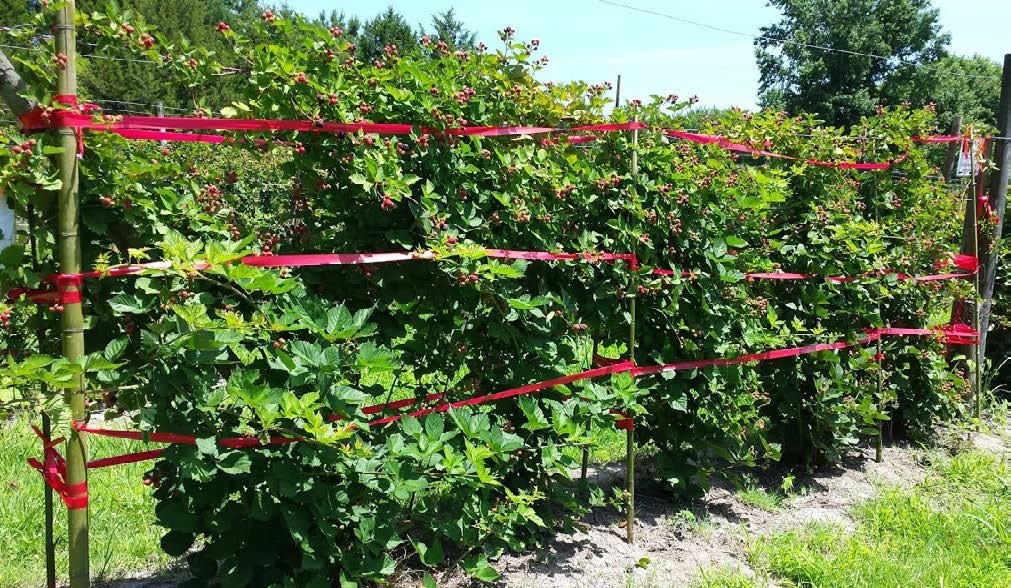
Information on year of release for each variety, total number of plants harvested per variety, plant spacing, age of plants, rainfall received during harvest period for each location, and data collected during the course of study are presented in tables 1 to 4. At pick-your-own locations in Williamsburg and Virginia Beach, blackberries were harvested twice a week by research personnel. At grower-picked sites, harvesting schedules varied. Total yield — which included U.S. No. 1 (commonly known as Grade A), U.S. No. 2, and unclassified berries — was measured using a digital scale (figs. 2 and 3).
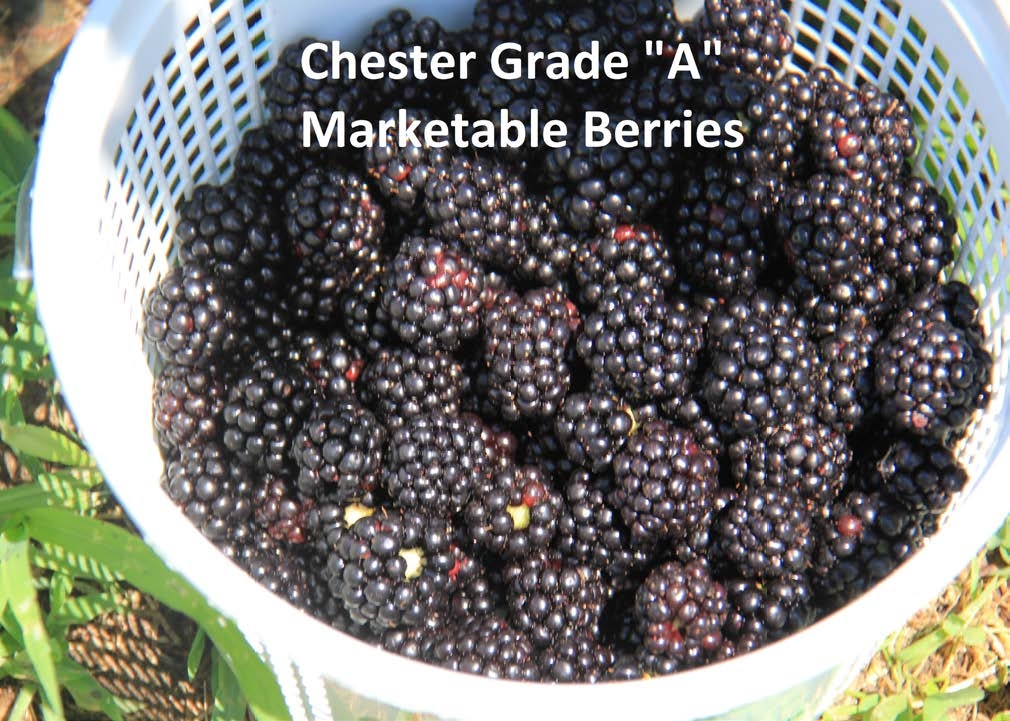
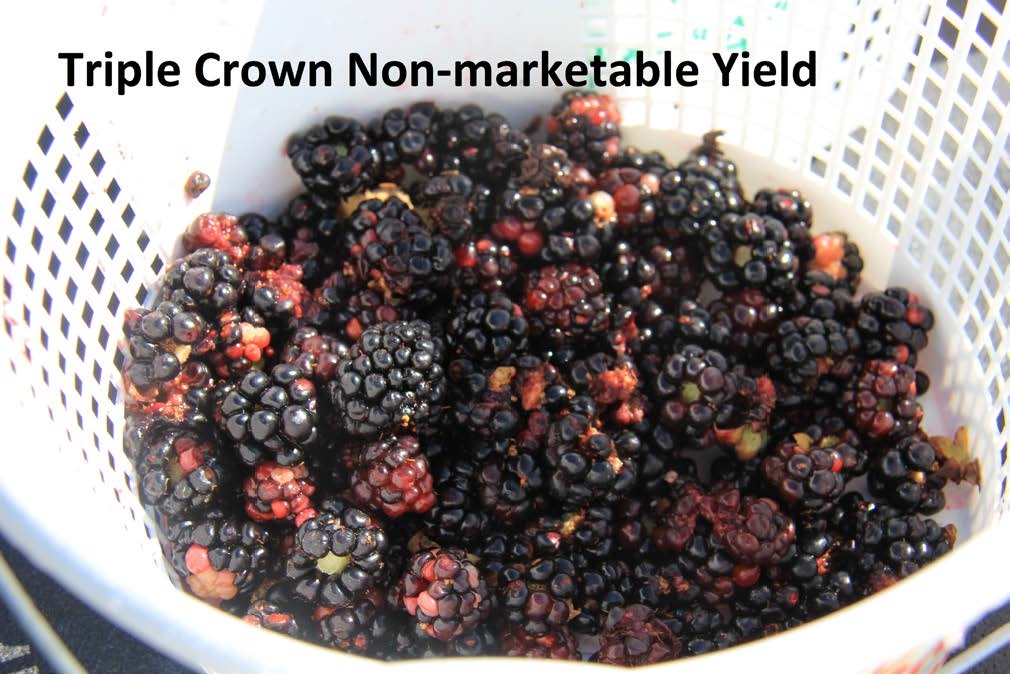
Data on Grade A berries and total yield per plant are listed in tables 1 through 4. U.S. No. 1 berries are considered firm, developed but not overripe, and dark black in color. They are free from disease, decay, or damage by insects or other mechanical means. U.S. No. 2 berries are berries that fail to meet the requirements of U.S. No. 1 berries. They do not contain more than 10 percent, by volume, of berries that are seriously damaged by any cause and not more than 2 percent of berries that are affected by mold and decay. Unclassified (unmarketable) berries cannot be used for processing or local or shipping markets (USDA 1997).
Degrees Brix and fruit size were assessed using five randomly selected berries chosen from a good representation of each individual harvest for each variety (fig. 4). This data is also presented in tables 1 through 4. Due to the nonrandomized and nonreplicated nature of the study, we were unable to run an analysis for mean separation on the data, and data presented are solely observational in nature.
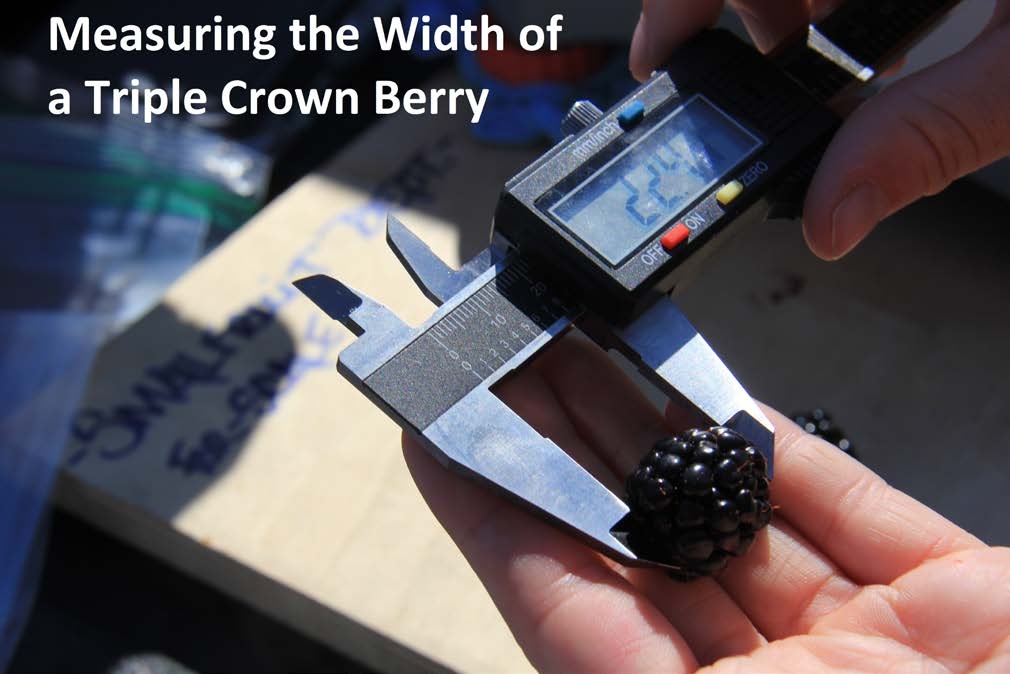
Findings and Discussion
Charlotte Court House
Observed Grade A yields were comparable for all three varieties, but total yield per plant was lower for ‘Ouachita’ (table 1). Values for degrees Brix and fruit size were high for ‘Ouachita’. The grower at Charlotte Court House used a foliar nutrient application (Sugar Express), which might have resulted in increased degrees Brix readings over other locations for ‘Navaho’ and ‘Ouachita’.
| Varietya | Year of release | No. of plants | Grade A (lb/plant) | Total yield (lb/plant) | Average (°Bxb) | Average fruit size (in2) | Harvest period | Rainfall (in) |
|---|---|---|---|---|---|---|---|---|
| Chester Thornless | 1985 | 3 | 5.1 | 7.1 | 8.5 | 0.7 | 7/29-9/4 | 4.0 |
| Navaho | 1989 | 3 | 5.4 | 6.8 | 12.0 | 0.7 | 7/3-8/12 | 4.2 |
| Ouachita | 2009 | 3 | 5.2 | 5.8 | 12.8 | 1.0 | 6/26-8/12 | 4.8 |
a All varieties were 2 years old and placed at 4-foot in-row spacing.
b Degrees Brix.
Mechanicsville
Yield values indicate that ‘Chester Thornless’ was a high-yielding variety (31.9 pounds total yield per plant) but with a smaller size berry and a lower degrees Brix reading than other varieties. ‘Apache’ grown on a rotating cross-arm trellis had a high degrees Brix reading, while ‘Kiowa’ and ‘Chickasaw’ produced large-sized fruits. For the early bearing varieties, observed yields for ‘Kiowa’ and ‘Chickasaw’ (thorny) were higher (12.1 and 8.9 pounds total yield per plant, respectively) than ‘Natchez’ and ‘Ouachita’ (thornless). For late-season varieties, the yield for ‘Chester Thornless’ was higher than for ‘Triple Crown’. ‘Apache’ grown with the support of a rotating cross-arm trellis had a higher yield (3.4 pounds total yield per plant) than ‘Apache’ grown using a standard T-trellis (2.6 pounds total yield per plant).
| Varietya | Year of release | No. of plants | Grade A (lb/plant) | Total yield (lb/plant) | Average (°Bxb) | Average fruit size (in2) | Harvest period | Rainfall (in) |
|---|---|---|---|---|---|---|---|---|
| Apache (RCAc) | 1999 | 3 | 2.9 | 3.4 | 9.8 | 1.0 | 7/10-8/7 | 1.5 |
| Apache | 1999 | 3 | 2.0 | 2.6 | 9.0 | 1.1 | 7/10-8/7 | 1.5 |
| Chester Thornless | 1985 | 3 | 23.2 | 31.9 | 8.3 | 0.8 | 7/10-9/8 | 4.4 |
| Chickasaw | 1999 | 3 | 7.5 | 8.9 | 8.7 | 1.5 | 6/18-8/1 | 3.0 |
| Kiowa | 1996 | 4 | 9.4 | 12.1 | 8.7 | 1.5 | 6/27-8/7 | 1.6 |
| Natchez | 2008 | 3 | 5.9 | 6.3 | 8.5 | 1.2 | 6/18-7/14 | 1.3 |
| Ouachita | 2009 | 3 | 4.4 | 5.2 | 9.0 | 0.9 | 6/27-8/4 | 1.6 |
| Triple Crown | 1996 | 2 | 7.9 | 13.5 | 9.0 | 1.0 | 7/4-8/7 | 1.6 |
a All varieties were 5 to 6 years old and placed at 3-foot in-row.
b Degrees Brix.
c Rotating crossarm trellis. All other varieties were trained on a standard T-trellis.
Virginia Beach
Yield values were high for ‘Chester Thornless’ (4.5-year-old plants) over ‘Triple Crown’ plants. The older plantings of ‘Triple Crown’ (15-year-old plants) had the highest degrees Brix value (10.7), while observed value for fruit size was comparable for all three varieties.
| Varietya | Year of release | No. of plants | Grade A (lb/plant) | Total yield (lb/plant) | Average (°Bxb) | Average fruit size (in2) | Harvest period | Rainfall (in) |
|---|---|---|---|---|---|---|---|---|
| Chester Thornlessc | 1985 | 4 | 8.3 | 19.2 | 9.7 | 0.8 | 7/3-8/21 | 11.1 |
| Triple Crown (Yd) | 1996 | 4 | 3.8 | 9.6 | 8.9 | 0.8 | 7/3-8/14 | 8.0 |
| Triple Crown (Oe) | 1996 | 5 | 3.9 | 7.7 | 10.7 | 0.8 | 7/3-8/14 | 8.0 |
a All varieties were placed at 5-foot in-row spacing.
b Degrees Brix.
c ‘Chester Thornless’ plantings were 4.5 years old.
d “Y” refers to younger ‘Triple Crown’ plantings at grower site that were 4.5 years old.
e “O” refers to older ‘Triple Crown’ plantings that were 15 years old.
Williamsburg
‘Navaho’ yield was high (4.8 pounds total yield per plant). Values of degrees Brix (10.8) and fruit size (1.1 square inch) for ‘Natchez’ were higher than other varieties.
Yield data and performance of varieties could have been affected by many environmental and cultural factors, including rainfall, soil properties, fertigation practices, plant spacing, pruning, and sanitation practices. Our observations suggest that the colder climates of Mechanicsville and Charlotte Court House seemed to have higher yields than the coastal locations. The marketable-yield-to-total-yield ratio was also higher in colder climate locations for all varieties grown. The ‘Chester Thornless’ marketable- yield-to-total-yield ratio was 0.7 at Charlotte Court House and Mechanicsville, and it was 0.4 at Virginia Beach. The marketable-yield-to-total-yield ratio for ‘Ouachita’ was 0.9 at Charlotte Court House and 0.5 at Williamsburg. Insect pressure for spotted winged drosophila (Drosophila suzukii) and Japanese beetle (Popillia japonica) was higher at coastal sites. These sites also received more rainfall for the duration of the bearing season (tables 1-4). The two coastal sites in Virginia Beach and Williamsburg offered pickyour- own options to their customers. Additionally, yields per plant at Williamsburg might have been affected by closer in-row plant spacing.
| Varietya | Year of release | No. of plants | Grade A (lb/plant) | Total yield (lb/plant) | Average (°Bxb) | Average fruit size (in2) | Harvest period | Rainfall (in) |
|---|---|---|---|---|---|---|---|---|
| Arapaho | 1993 | 4 | 0.6 | 1.5 | 10.5 | 0.7 | 6/23-8/7 | 6.2 |
| Natchez | 2008 | 3 | 1.2 | 2.7 | 10.8 | 1.1 | 6/19-7/21 | 4.4 |
| Navaho | 1989 | 3 | 2.2 | 4.8 | 10.3 | 0.7 | 6/26-8/15 | 6.2 |
| Ouachita | 2009 | 4 | 1.0 | 2.1 | 10.3 | 0.8 | 6/23-8/7 | 6.2 |
| Triple Crown | 1996 | 3 | 0.7 | 3.3 | 9.4 | 0.6 | 7/02-8/11 | 6.1 |
a All varieties were 6 years old and placed at 1.5-foot in-row spacing.
b Degrees Brix.
Summary
There has been an increasing interest in establishing blackberries in Virginia farms. This study findings provide valuable insight, assisting growers with variety selection. For example, growers interested in high yields should consider ‘Chester Thornless’ (fig. 5), while large-size fruits were observed in the thorny varieties ‘Chickasaw’ and ‘Kiowa’.
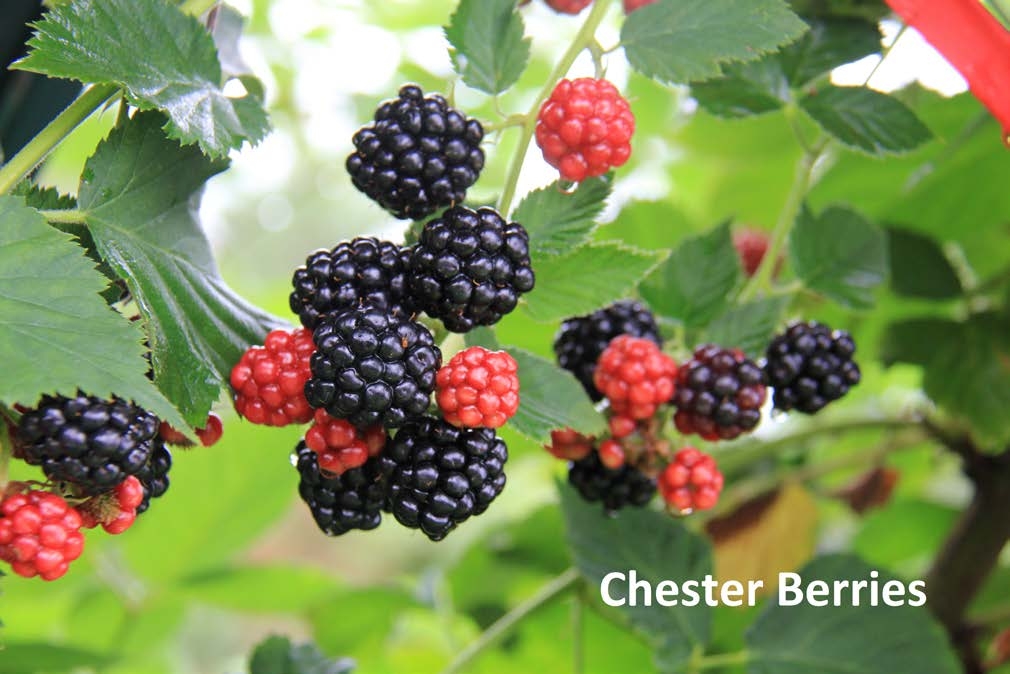
Grower Suggestions
Using pick-your-own harvesting can be a challenge for growers trying to keep up with clean picking the plants (i.e., picking all ripe berries off the plant as well as any diseased, misshapen, or damaged fruit). Customers only pick the most attractive fruit located at the optimal cane height. Unless growers go back and pick the remaining ripe fruits from berry plants following the pickyourown activity of customers, unpicked fruits become overripe and decay. Most growers refrain from this sanitation practice primarily because of labor shortages and costs involved. Decaying berry fruit will serve as a host for insects and diseases. This in turn leads to an increase in the number of pesticide sprays needed during harvest season to keep insect and disease damage under check. Production costs go up with increasing pesticide sprays. The grower can help reduce some of these issues through proper farm planning strategies that include putting careful thought into the number of plants that one can manage and the needs of the market. Growers must follow recommended in-row spacing to improve airflow. This spacing for thorny blackberry varieties is 3 feet; for thornless blackberries, the spacing is 4 to 6 feet (Demchak 2013).
The data presented here were collected at grower sites in a single harvest season. The varieties were not replicated over space or time, and so it is possible that the performances of varieties could vary over years. Nonetheless, given that there is no documented data on performance of commercially grown varieties in Virginia, the study findings provide valuable insight, assisting growers with variety selection. Those interested in keeping strawberry farm stands and pick-your-own operations open for longer durations of time, should consider the early season fruiting varieties and use the observed data from this study as an indicator of what the variety-bearing potential could be.
Acknowledgments
Funding for this study was provided by the Virginia Agricultural Council. The authors would like to extend their gratitude to Kelly Jacobson and Sydney Covey. Special appreciation for use of established crops and onsite land access is extended to Robert Jones, Lorri and Dave Barron, Pierson Geyer, Juanita and Robert Burns, and Bill Apperson. Their knowledge and guidance provided during the development of this research study is greatly appreciated. Thanks also to Dr. Hannah Burrack, Dr. Charles Johnson, and Roy Flanagan III for reviewing this publication.
References
Demchak, K., ed. 2013. “Brambles.” In The Mid-Atlantic Berry Guide for Commercial Growers, 2013-2014, 171-224. Publication Code AGRS-097. University Park, PA: Penn State Cooperative Extension.
USDA (U.S. Department of Agriculture). (1928) 1997. United States Standards for Grades of Dewberries and Blackberries
https://www.ams.usda.gov/sites/default/files/media/Fresh_Dewberry-Blackberry_Standard%5B1%5D.pdf.
USDA-ARS (U.S. Department of Agriculture), Agricultural Research Service. 2012. “USDA Plant Hardiness Zone Map.” http://planthardiness.ars.usda.gov/PHZMWeb/.
U.S. Department of Agriculture. Census of Agriculture. 2015. “2012 Census Volume 1, Chapter 1: State Level Data Virginia.”
www.agcensus.usda.gov/Publications/2012/Full_Report/Volume_1_Chapter_1_State_Level
/Virginia/.
Virginia Cooperative Extension materials are available for public use, reprint, or citation without further permission, provided the use includes credit to the author and to Virginia Cooperative Extension, Virginia Tech, and Virginia State University.
Virginia Cooperative Extension is a partnership of Virginia Tech, Virginia State University, the U.S. Department of Agriculture (USDA), and local governments, and is an equal opportunity employer. For the full non-discrimination statement, please visit ext.vt.edu/accessibility.
Publication Date
May 6, 2022



